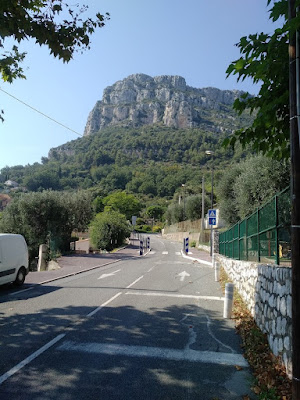Saint Jeannet is a pretty Provencal village not far from Vence. It is on what is called the Route des Villages Perchés, a number of places perched on hills (another of which is called Tourette). Together with Bellet it could claim to be the wine of Nice but sadly it is even less well known.
two of 13 siblings, Georges Rasse and his brother Paul Denis are the only vignerons left in Saint Jeannet. Georges told us that when he was born, the population of St. Jeannet was 700 and there were about 700 vignerons. Now the population is 4,000 and there are only two!
This would be a pity in any circumstances but in this case it is particularly poignant because not only is the wine unique but there was even a St. Jeannet variety of grape up to the beginning of the last century.
We have already told the story in this blog of how immigrants to South America took St. Jeannet cuttings with them and planted them in Argentina. Meanwhile, the variety had become extinct in its native habitat. Georges Rasse explained that in fact it is a dessert grape and a rather acidic one at that but he was bringing it back with plantings of his own. He and no doubt his brother too are enterprising people.
Unique wines? Yes, because at least some of them at George Rasse's vineyard 'Domaine des Hautes Collines' are 'eleve en bonbonne au soleil'. The Bonbonnes are demijohns. As can be seen from the photo they are set out in the sun without their straw or plastic covering. This 'elevage' can last between 3 and 8 months.
The actual grape varieties used in the Rasse family wines are eclectic if not unknown;
Chardonnay
Chasan
Chenonson
Grenache Blanc
Marsanne
Muscat d'Alexandrie
Rolle (Vermentino)
Sauvignon Blanc
Semillon
Ugni Blang (Trebbiano)
Viognier
Braquet
Cabernet Sauvignon
Gamay
Grenache
Malbec
Merlot
Mourvedre
Syrah
and 'coming soon' according to the website are
Borboulenc
Cortese
Ribolla
Verdicchio
Aglianico
Barbera
Lagrein
Nebbiolo
Nero d'Avola
Sagrantino
Tibouren (Rossese)
All this on only 4 ha.
The apellation is 'Indication Geographique Protegee Alpes Maritimes.'
St. Jeannet sits under a famous rocky feature called the Baou. Labels of some Rasse wines with paintings by George Rass's brother depict this Baou as can be seen above.
Roman remains of a wine press have been discovered on the property so many wines are named 'Cuvee du Pressoir Romain.'
Unsurprisingly M. George Rasse makes a broad range of wines (his brother rather less extensive).
They are varied and interesting;
Cuvee St. Jeannet Tardif dessert wine (from Sauvignon Blanc?).
Cuvee Rancio aperitif wine.
Tuilé de Saint Jeannet 'eleve en bonbonne au soleil' rose. Tuilé means curled or tiled so we're not sure what the name signifies.
The Cuvee Longo Mai is made from the best red grapes from Merlot, Cabernet Sauvignon, Syrah, Grenache, Mourvèdre and Braquet. Longo Mai seems to be the (Provencal) name of the vineyard.
It is difficult to obtain details but 'A l'Unisson' (meaning in unison) might be a field blend of white grapes.
Blanc Prestige. The best white grapes picked at maximum maturity and aged in American oak.
The tasting room is cosy with the myriad cuvees on display. Georges Rasse is happy to open as many bottles as you like and to give you a shot of even his rarest wines such as the Tardif and Rancio of which he makes only a handful of bottles.
The Chaix is just around the corner.
We bought
the Cuvee du Pressoir Romain 2017 at 13.5%
and the Cuvee du Pressoir Romain rosé 2017 also 13.5%. This is a really aromatic rosé, totally different from what you might imagins as a rosé de Provence.
Over at the other Rasse family vineyard, they produce this red which we found in the market in Vence.
Rasse family wines are not widely available even in France. In any case there is not a huge quantity but they are well worth seeking out and a visit to the vineyard is absolutely fascinating.
Just for the record, there seem to be no less thjan three wines from Argentina which use the St. Jeannet variety in their blends;
 |
| Finca El Reposo Cuvee St. Jeannet |
 |
| and Allamand Cuvee Saint Jeannet |






















No comments:
Post a Comment